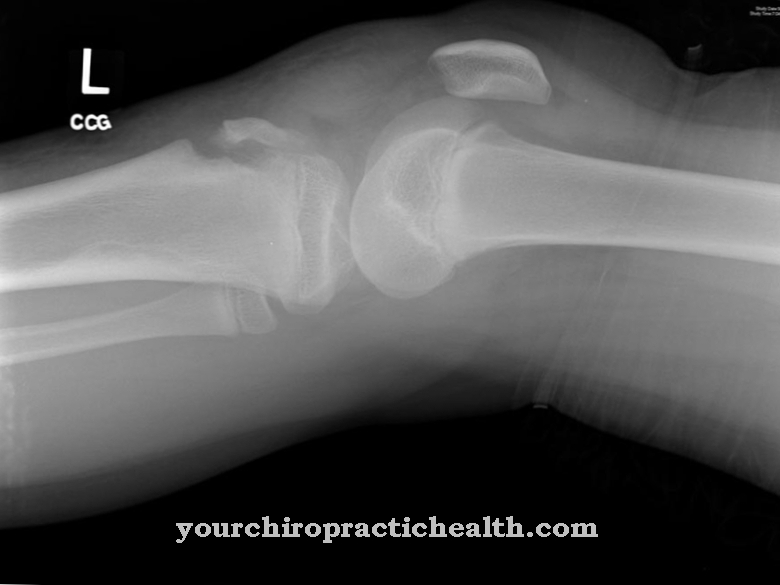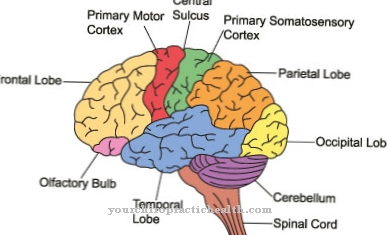The Spinal cord concussion or Spinal commotio is the easiest stage of spinal cord injury and occurs, for example, in the context of accidents. In contrast to the more severe forms, no spinal cord lesion can be detected in the radiological examination of the spinal commotion. Symptoms such as micturition disorders or reflex failures subside by themselves about 48 hours after the incident.
What is spinal commotio?

© 4th Life Photography - stock.adobe.com
The spinal cord is part of the central nervous system and, with its pyramidal tracts, plays an important role in controlling human movements. Spinal cord trauma is damage or injury to the spinal cord or its surroundings, which are often associated with impaired movement control.
Basically, damage to the spinal cord is divided into three different stages, which differ in their severity. In addition to the spinal cord contusion (Compressio spinalis), there is also a spinal cord contusion (Contusio spinalis). The mildest stage of the spinal cord injury is the spinal cord vibration, also known as the commotio spinalis.
In contrast to the other stages, this stage of the spinal cord injury is characterized by only temporarily predominant symptoms of failure in neurological stimulus transmission, which can be attributed to the action of mechanical force.
causes
Commotio spinalis is caused by a physical mechanical force acting on the spine. In most cases, the spinal cord tremor is caused by short-term and indirect violence on the spinal canal of the spinal cord. This type of violence can occur, for example, in a car accident, an accident at work or a sports accident.
The decisive factor is the time limit for the impact of violence. In the event of prolonged or direct violence on the spinal cord, a spinal cord contusion or compression is more likely than a spinal cord tremor. In contrast to the other two stages, no manifest injury to the spinal cord can be demonstrated in the case of spinal cord vibration.
In other words, the brief force of violence left no verifiable traces, but can only be guessed based on the symptoms.
You can find your medication here
➔ Medicines for back painSymptoms, ailments & signs
The exact symptoms of the commotio spinalis depend on the one hand on the severity and on the other hand on the exact location of the violence. Light acts of violence lead to emotional disturbances, especially in the extremities.
Medium-class violence can be associated with a disturbance of the reflex function or micturition disorders, while with strong violence on certain areas of the spinal cord, manifest symptoms of paralysis of the extremities are also conceivable.
In contrast to spinal cord contusion and spinal cord contusion, all symptoms of spinal cord tremors subside by themselves after 48 hours at the latest. In most cases, those affected only suffer from mild pain. Often those affected show further trauma, since the spinal commotio is usually the result of an accident.
Diagnosis & course
The diagnosis of a commotio spinalis is made by a neurologist. In the diagnosis, it is important to distinguish it from other stages of the spinal cord injury. In addition to taking the medical history, the neurologist conducts a reflex examination. The failure of reflex physiological movements can indicate a spinal cord injury.
The same applies to reflex pathological movements with a corresponding anamnesis. The distinction between the commotio spinalis and other spinal cord injuries can only be achieved through imaging. A radiologically visible spinal cord injury is not a commotio spinalis.
If the spinal cord appears to be radiologically intact, but there are still reflex deficits or similar symptoms, the diagnosis of spinal cord vibration is an obvious one. The prognosis for patients with spinal cord vibration is favorable. Irreversible damage does not occur.
Complications
In most cases, reflexes fail and paralysis occurs in the spinal commotion. As a rule, these do not occur immediately, but rather only after the accident. The spinal commotio leads to relatively strong sensory disturbances. These can occur in different parts of the body and thus restrict movement and generally the everyday life of the person concerned relatively strongly.
The extremities can be paralyzed, so that the person concerned is dependent on a walking aid or a wheelchair. It is also not uncommon for pain to occur. The symptoms of the commotio spinalis do not last long, but in most cases disappear after a few days, so that there are no permanent complications or restrictions. Complications can arise mainly from the accident.
If the symptoms and the pain of the commotio spinalis do not go away on their own, treatment with painkillers or therapies is necessary. This usually leads to success and no further complications arise. It is not uncommon for patients to have psychological care after the accident in order to deal with the accident itself and the consequences of it.
When should you go to the doctor?
In most cases, this complaint does not require any special medical treatment. However, complaints from this doctor should be examined by a doctor, especially after an accident, in order to avoid further complications and possibly permanent paralysis. A doctor should then be consulted if there are disorders of sensitivity or various paralysis of the patient's body. These can occur in different regions.
The affected person's reflexes are also negatively affected and can be significantly restricted. A medical examination is particularly necessary if these symptoms do not subside on their own within 48 hours. Usually the disease can be diagnosed on a radiological examination. First and foremost, however, a visit to a general practitioner is required. If the complaints and symptoms go away on their own, no special treatment for this disease is usually necessary and the disease progresses positively.
Doctors & therapists in your area
Treatment & Therapy
The spinal cord vibration requires, above all, protection. The patient ideally stays calm for the next few days and enjoys bed rest. Since the symptoms subside after two days, no further treatment is usually required. This relationship distinguishes spinal cord concussion from other stages of spinal cord injury.
Since the patient can suffer from more or less severe pain even with a spinal commotion, conservative drug treatment with painkillers is an option in addition to therapeutic protection. However, this procedure is only indicated if there is actually severe pain and the quality of life of the person affected is clearly impaired by the pain symptoms for the next few days.
Mild pain can generally be a good indicator of the prevalence and subsidence of the shock. Once the mild pain has subsided, this is an indication of the patient's full recovery. The reflex examination should be repeated after 48 hours.
If pathological reflex behavior is still present, further imaging may be indicated. In rare cases, more severe spinal cord injuries do not show up on the initial imaging and only develop to their actual extent in the days after the violence.
If the imaging after 48 hours still does not provide any evidence of an actually manifest spinal cord injury, but neurological deficits persist, there may be a psychosomatic cause. In this case, the patient is instructed to deal with the accident situation and its consequences in psychotherapeutic care.
Outlook & forecast
The spinal commotio has a favorable prognosis. The symptoms are not permanent and gradually subside within a few days. The self-healing powers of the person become active and alleviate the symptoms without further intervention by a doctor.
Depending on the severity of the damage, the healing process can last for one to two weeks. Thereafter, there is usually no symptoms. As soon as the patient adheres to the doctor's instructions and instructions, he will notice a significant improvement in his well-being after just 48 hours.
Permanent impairments are not to be expected with the spinal commotion. Consequences only occur in very rare cases. They are mostly based on further violence or disregard of the medical guidelines. The patient needs a few days of rest and rest to heal. If more intense physical activity occurs during this time, health can deteriorate and the symptoms increase.
Vibrations in particular are to be avoided so that the good prognosis is maintained. If the patient suffers from a sequela, then it is usually linked to the cause of the force or violence. The triggering event can lead to sleep disorders, nightmares, trauma, or an anxiety disorder.
You can find your medication here
➔ Medicines for back painprevention
A spinal commotio can only be prevented to the extent that the effects of force on the spinal cord can be prevented. Since accidents can never be completely ruled out, preventive measures are limited. Nevertheless, studies show that a trained back is more likely to deal with the effects of violence unharmed than an untrained back.
For this reason, back training or attending a back school can make sense as a preventive measure in connection with the commotio spinalis. Anyone who has problems with their intervertebral discs, for example, is all the more susceptible to spinal cord tremors or even the more severe stages of spinal cord injury in an accident situation. For this reason, all efforts to improve back health are largely regarded as preventive measures for spinal cord injuries.
You can do that yourself
Independent measures for healing can only be carried out to a limited extent in the case of spinal cord vibration. Self-help in this disease is therefore geared towards a supportive influence in the recovery process.
Sufficient rest, protection and only a low load on the back help so that the symptoms can be alleviated as quickly as possible. The conditions during night sleep should be viewed critically and optimized if necessary. The back needs a healthy sleeping position so that the healing process is promoted. Jerky movements of the upper body should always be avoided.
Likewise, the body should not be exposed to vibrations from hopping, jumping or running. Slow and steady movements are recommended. In terms of posture, care must be taken that there is no tilted posture or incorrect one-sided stress. This puts unnecessary stress on the skeletal system and can impair the supply of muscles, nerves or tendons.
In the case of leisure activities and the practice of sports, it should be checked whether these are beneficial during the recovery process. Visiting the rides at an amusement park, as well as participating in ball sports or fitness training, is not recommended. Exercises or environments that encourage relaxation are helpful. This strengthens well-being and prevents the back from being exposed to unnecessary strain. In addition, the immune system can be supported with a healthy diet.

.jpg)
.jpg)


.jpg)
.jpg)




















